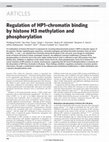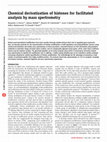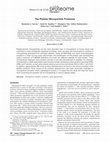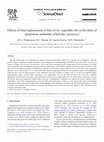Papers by Benjamín García

Biochemistry, 2005
Phosphorylation of histone H3 is a hallmark event in mitosis and is associated with chromosome co... more Phosphorylation of histone H3 is a hallmark event in mitosis and is associated with chromosome condensation. Here, we use a combination of immobilized metal affinity chromatography and tandem mass spectrometry to characterize post-translational modifications associated with phosphorylation on the N-terminal tails of histone H3 variants purified from mitotically arrested HeLa cells. Modifications observed in vivo on lysine residues adjacent to phosphorylated Ser and Thr provide support for the existence of the "methyl/phos", binary-switch hypothesis [Fischle, W., Wang, Y., and Allis, C. D. (2003) Nature 425, 475-479]. ELISA with antibodies selective for H3 at Ser10, Ser28, and Thr3 show reduced activity when adjacent Lys residues are modified. When used together, mass spectrometry and immunoassay methods provide a powerful approach for elucidation of the histone code and identification of histone post-translational modifications that occur during mitosis and other specific cellular events.

Journal of Proteome Research, 2004
We describe the design and performance of a prototype high performance hybrid mass spectrometer. ... more We describe the design and performance of a prototype high performance hybrid mass spectrometer. This instrument consists of a linear quadrupole ion trap (QLT) coupled to a Fourier transform ion cyclotron resonance mass analyzer (FTMS). This configuration provides rapid and automated MS and MS/MS analyses, similar to the "data dependent scanning" found on standard 3-D Paul traps, but with substantially improved internal scan dynamic range, mass measurement accuracy, mass resolution, and detection limits. Sequence analysis of peptides at the zeptomole level is described. The recently released, commercial version of this instrument operates in the LC/MS mode (1 s/scan) with a mass resolution of 100 000 and is equipped with automatic gain control to provide mass measurement accuracy of 1-2 ppm without internal standard. Methodology is described that uses this instrument to compare the post-translational modifications present on histone H3 isolated from asynchronously growing cells and cells arrested in mitosis.

Nucleic Acids Research, 2004
Chromatin is regulated at many different levels, from higher-order packing to individual nucleoso... more Chromatin is regulated at many different levels, from higher-order packing to individual nucleosome placement. Recent studies have shown that individual histone modifications, and combinations thereof, play a key role in modulating chromatin structure and gene activity. Reported here is an analysis of Arabidopsis histone H3 modifications by nanoflow-HPLC coupled to electrospray ionization on a hybrid linear ion trap-Fourier transform mass spectrometer (LTQ/FTMS). We find that the sites of acetylation and methylation, in general, correlate well with other plants and animals. Two well-studied modifications, dimethylation of Lys-9 (correlated with silencing) and acetylation of Lys-14 (correlated with active chromatin) while abundant by themselves were rarely found on the same histone H3 tail. In contrast, dimethylation at Lys-27 and monomethylation at Lys-36 were commonly found together. Interestingly, acetylation at Lys-9 was found only in a low percentage of histones while acetylation of Lys-14 was very abundant. The two histone H3 variants, H3.1 and H3.2, also differ in the abundance of silencing and activating marks confirming other studies showing that the replicationindependent histone H3 is enriched in active chromatin.
Genes & Development, 2006
Histone deacetylase (HDAC) inhibitors perturb the cell cycle and have great potential as anti-can... more Histone deacetylase (HDAC) inhibitors perturb the cell cycle and have great potential as anti-cancer agents, but their mechanism of action is not well established. HDACs classically function as repressors of gene expression, tethered to sequence-specific transcription factors. Here we report that HDAC3 is a critical, transcription-independent regulator of mitosis. HDAC3 forms a complex with A-Kinase-Anchoring Proteins AKAP95 and HA95, which are targeted to mitotic chromosomes. Deacetylation of H3 in mitosis requires

Nature, 2005
Tri-methylation of histone H3 lysine 9 is important for recruiting heterochromatin protein 1 (HP1... more Tri-methylation of histone H3 lysine 9 is important for recruiting heterochromatin protein 1 (HP1) to discrete regions of the genome, thereby regulating gene expression, chromatin packaging and heterochromatin formation. Here we show that HP1a, -b, and -g are released from chromatin during the M phase of the cell cycle, even though tri-methylation levels of histone H3 lysine 9 remain unchanged. However, the additional, transient modification of histone H3 by phosphorylation of serine 10 next to the more stable methyl-lysine 9 mark is sufficient to eject HP1 proteins from their binding sites. Inhibition or depletion of the mitotic kinase Aurora B, which phosphorylates serine 10 on histone H3, causes retention of HP1 proteins on mitotic chromosomes, suggesting that H3 serine 10 phosphorylation is necessary for the dissociation of HP1 from chromatin in M phase. These findings establish a regulatory mechanism of protein-protein interactions, through a combinatorial readout of two adjacent post-translational modifications: a stable methylation and a dynamic phosphorylation mark.

Journal of Biological Chemistry, 2006
Histone lysine (K) acetylation is a major mechanism by which cells regulate the structure and fun... more Histone lysine (K) acetylation is a major mechanism by which cells regulate the structure and function of chromatin, and new sites of acetylation continue to be discovered. Here we identify and characterize histone H3K36 acetylation (H3K36ac). By mass spectrometric analyses of H3 purified from Tetrahymena thermophila and Saccharomyces cerevisiae (yeast), we find that H3K36 can be acetylated or methylated. Using an antibody specific to H3K36ac, we show that this modification is conserved in mammals. In yeast, genome-wide ChIP-chip experiments show that H3K36ac is localized predominantly to the promoters of RNA polymerase II-transcribed genes, a pattern inversely related to that of H3K36 methylation. The pattern of H3K36ac localization is similar to that of other sites of H3 acetylation, including H3K9ac and H3K14ac. Using histone acetyltransferase complexes purified from yeast, we show that the Gcn5-containing SAGA complex that regulates transcription specifically acetylates H3K36 in vitro. Deletion of GCN5 completely abolishes H3K36ac in vivo. These data expand our knowledge of the genomic targets of Gcn5, show H3K36ac is highly conserved, and raise the intriguing possibility that the transition between H3K36ac and H3K36me acts as an "acetyl/methyl switch" governing chromatin function along transcription units.

Nature Protocols, 2007
Histone post-translational modifications have been recently intensely studied owing to their role... more Histone post-translational modifications have been recently intensely studied owing to their role in regulating gene expression. Here, we describe protocols for the characterization of histone modifications in both qualitative and semiquantitative manners using chemical derivatization and tandem mass spectrometry. In these procedures, extracted histones are first derivatized using propionic anhydride to neutralize charge and block lysine residues, and are subsequently digested using trypsin, which, under these conditions, cleaves only the arginine residues. The generated peptides can be easily analyzed using online LC-electrospray ionization-tandem mass spectrometry to identify the modification site. In addition, a stable isotope-labeling step can be included to modify carboxylic acid groups allowing for relative quantification of histone modifications. This methodology has the advantage of producing a small number of predicted peptides from highly modified proteins. The protocol should take approximately 15-19 h to complete, including all chemical reactions, enzymatic digestion and mass spectrometry experiments.
Current Opinion in Chemical Biology, 2007
Histone proteins and their accompanying post-translational modifications have received much atten... more Histone proteins and their accompanying post-translational modifications have received much attention for their ability to affect chromatin structure and, hence, regulate gene expression. Recently, mass spectrometry has become an important complementary tool for the analysis of histone variants and modification sites, for determining the degree of occupancy of these modifications and for quantifying differential expression of these modifications from various samples. Additionally, as advancements in mass spectrometry technologies continue, the ability to read entire 'histone codes' across large regions of histone polypeptides or intact protein is possible. As chromatin biology demands, mass spectrometry has adapted and continues as a key technology for the analysis of gene regulation networks involving histone modifications.

Journal of Proteome Research, 2005
The baseline level of gene expression varies between healthy controls and systemic lupus erythema... more The baseline level of gene expression varies between healthy controls and systemic lupus erythematosus (SLE) patients, and among SLE patients themselves. These variations may explain the different clinical manifestations and severity of disease observed in SLE. Epigenetic mechanisms, which involve DNA and histone modifications, are predictably associated with distinct transcriptional states. To understand the interplay between various histone modifications, including acetylation and methylation, and lupus disease, we performed differential expression histone modification analysis in splenocytes from the MRL-lpr/lpr mouse model of lupus. Using stable isotope labeling in combination with mass spectrometry, we found global site-specific hypermethylation (except H3 K4 methylation) and hypoacetylation in histone H3 and H4 MRL-lpr/lpr mice compared to control MRL/MPJ mice. Moreover, we have identified novel histone modifications such as H3 K18 methylation, H4 K31 methylation, and H4 K31 acetylation that are differentially expressed in MRL-lpr/lpr mice compared to controls. Finally, in vivo administration of the histone deacetylase inhibitor trichostatin A (TSA) corrected the site-specific hypoacetylation states on H3 and H4 in MRL-lpr/lpr mice with improvement of disease phenotype. Thus, this study is the first to establish the association between aberrant histone codes and pathogenesis of autoimmune disease SLE. These aberrant post-translational histone modifications can therefore be reset with histone deacetylase inhibition in vivo.

Journal of Proteome Research, 2005
Platelet-derived microparticles are the most abundant type of microparticle in human blood and co... more Platelet-derived microparticles are the most abundant type of microparticle in human blood and contribute to many biologically significant processes. Here, we report the first proteomic analysis of microparticles generated from activated platelets. Using 1D SDS-PAGE and liquid chromatography coupled to a linear ion trap mass spectrometer, the identification of 578 proteins was accomplished using a minimum of 5 MS/MS detections of at least two different peptides for each protein. These microparticles displayed many proteins intrinsic to and well-characterized on platelets. For example, microparticles in these experiments were found to contain membrane surface proteins including GPIIIa, GPIIb, and P-selectin, as well other platelet proteins such as the chemokines CXCL4, CXCL7, and CCL5. In addition, approximately 380 of the proteins identified were not found in two previous studies of the platelet proteome. Since several of the proteins detected here have been previously implicated in microparticle formation and/or pathological function, it is hoped that this study will help fuel future work concerning the possible role of microparticles in various disease states.

Journal of Proteome Research, 2004
Recent studies have suggested that protein phosphorylation of glutamate receptors may play an imp... more Recent studies have suggested that protein phosphorylation of glutamate receptors may play an important role in synaptic transmission. Specifically, the phosphorylation of AMPA receptors has been implicated in cellular models of synaptic plasticity. The phosphorylation of the glutamate receptor 1 (GluR1) subunit of AMPA receptors by protein kinase A (PKA), protein kinase C (PKC), and Ca 2ϩ /calmodulin-dependent protein kinase II (CaMKII) has been characterized extensively. Phosphorylation of this subunit occurs exclusively on the intracellular C-terminal domain. However, the GluR1 subunit C terminus shows low homology to the other AMPA receptor subunits. In this paper we characterized the phosphorylation of AMPA receptor subunit GluR4, using site-specific mutagenesis and bio-chemical techniques. We found that GluR4 is phosphorylated on serine 842 within the C-terminal domain in vitro and in vivo. Serine 842 is phosphorylated by PKA, PKC, and CaMKII in vitro and is phosphorylated in transfected cells by PKA. Twodimensional phosphopeptide analysis indicates that serine 842 is the major phosphorylation site on GluR4. In addition, we identified threonine 830 as a potential PKC phosphorylation site. These results suggest that GluR4, which is the most rapidly desensitizing AMPA receptor subunit, may be modulated by phosphorylation.

Methods, 2005
Protein phosphorylation has been known to be a pivotal modification regulating many cellular acti... more Protein phosphorylation has been known to be a pivotal modification regulating many cellular activities and functions. Except for several conventional techniques, mass spectrometry-based strategies are increasingly considered as vital tools that can be utilized to characterize phosphorylated peptides or proteins. In this article, we summarized currently available mass spectrometry-based techniques for the analysis of phosphorylation. Due to the low abundance of phosphopeptides, enrichment steps such as specific antibodies, immobilized metal affinity chromatography, and specific tags are crucial for their use in detection. Since the non-specific binding of the enrichment techniques are constantly of major concerns, phosphatase treatment, neutral loss scan, or precursor ion scan enable the recognition of the phosphopeptide signals. In addition, quantitative methods including isotope labeling and mass tags are also discussed. Phosphoproteome analysis seems to provide elucidation of signaling networks and global decipherment of cell activities, which require powerful analytical methods for complete and routine identification of the phosphorylation event. Despite that numerous approaches have been exploited, comprehensive analysis of protein phosphorylation remains a challenging task. With the progressively more improvements of instruments and methodologies, we can foresee the implementation of a comprehensive approach for the analysis of phosphorylation states of proteins.

Cell, 2008
Chromatin undergoes developmentally-regulated structural and chemical changes as cells differenti... more Chromatin undergoes developmentally-regulated structural and chemical changes as cells differentiate, which subsequently lead to differences in cellular function by altering patterns of gene expression. To gain insight into chromatin alterations that occur during mammalian differentiation, we turned to a mouse embryonic stem cell (ESC) model. Here we show that histone H3 is proteolytically cleaved at its N-terminus during ESC differentiation. We map the sites of H3 cleavage and identify Cathepsin L as a protease responsible for proteolytically processing the N-terminal H3 tail. In addition, our data suggest that H3 cleavage may be regulated by covalent modifications present on the histone tail itself. Our studies underscore the intriguing possibility that histone proteolysis, brought about by Cathepsin L and potentially other family members, plays a role in development and differentiation that was not previously recognized.

Aquaculture, 2006
Macronutrient selection and responses to dietary protein dilution were investigated in 95-g sharp... more Macronutrient selection and responses to dietary protein dilution were investigated in 95-g sharpsnout seabream, an omnivorous fish species of interest for Mediterranean aquaculture. Five groups of 18 sharpsnout seabream were distributed among circular 450-l tanks and allowed to self-feed from 3 feeders each of which distributed feeds composed of different pairs of macronutrients: PC (75% protein, 25% carbohydrate), PF (75% protein, 25% fat) or FC (50% fat, 50% digestible carbohydrate). Regardless of self-feeders position, the fish composed a diet containing 63% protein, 19% fat and 18% carbohydrate. When the protein-containing diets (PC and PF) were diluted 50% with cellulose, the fish increased their food intake to compensate for the energy dilution (170 kJ/kg BW/day vs. 168 kJ/kg BW/day after dilution), and dietary composition (63% protein, 16% fat and 21% carbohydrate) did not change significantly. These results demonstrate that sharpsnout seabream can select from incomplete diets to compose a balanced diet, and the fish are also able to compensate for a dietary dilution to regulate both energy intake and the relative proportions of macronutrients. D

Aquaculture, 2007
The aim of this study was to determine the impact of dietary replacement of fish oil by vegetable... more The aim of this study was to determine the impact of dietary replacement of fish oil by vegetable oils on sharpsnout seabream growth, nutritive utilization, somatic parameters, body composition, feed digestibility, and muscle fatty acid profile, as well as to make an estimate of its economic repercussions. To this end, three isonitrogenous (48% crude protein) and isoenergetic (23 MJ/kg) experimental diets were formulated, using three different lipid sources: fish oil (FO), soybean oil (SO) and linseed oil (LO). These diets were fed to triplicate groups of 30 sharpsnout seabream with an initial average weight of 14.9 g, three times a day to apparent satiation, over 92 days at 24.6 ± 1.1°C. Our results show that the replacement of fish oil with soybean or linseed oil in sharpsnout seabream diets does not affect growth or feed utilization after three months of feeding. Fish on an SO diet exhibited higher hepatosomatic indices, whereas fillet percentages were significantly lower in fish that had been fed an FO diet. Apparent digestibility coefficients for dry matter, crude protein and crude lipid were significantly lower in fish that had consumed an LO diet. The muscle fatty acid composition reflected that of the diet. Consumption of vegetable oils reduced the muscle content of ARA (arachidonic acid), EPA (eicosapentaenoic acid) and DHA (docosahexaenoic acid) to a lower degree than their corresponding reductions in the diet after fish oil replacement, which highlights their importance. Vegetable oils also increased the muscle content of linoleic and linolenic acids. In terms of economic performance, the SO diet was the least expensive diet, and had the best economic conversion ratio.

Aquaculture International, 2002
The first attempts at applying aquacultural techniques to sharpsnoutseabream (Diplodus puntazzo) ... more The first attempts at applying aquacultural techniques to sharpsnoutseabream (Diplodus puntazzo) have proved very promising.One of the factors to keep in mind when analysing the viability of a speciesforindustrial farming is that of consumer acceptance of the product, a variablethat can be measured by sensory evaluation tests. To that end, 107 participantsfrom a number of work centres were assessed with hedonic sensory tests usingsharpsnout seabream samples. For reference purposes, the tasting also includedgilthead seabream samples. Participants were asked to fill out a questionnairethat included questions concerning their preferences for any one fish. Weanalysed the sensory attributes of both fish species using a hedonic scale, andalso their acceptability (disposition to purchase) to consumers. The resultsproved fairly encouraging with a view to sharpsnout seabream large-scaleproduction. All attributes tested in the sensory profile analysis werepositively rated. About 60% of the surveyed population would consider buyingsharpsnout seabream at a price similar to that of gilthead seabream (10∈),and 85% found it to be pleasing to the eye. Aside from flavour, its texture,juiciness and fat level are the most important appraisal attributes. Efforts toimprove the organoleptic characteristics of the species should focus mainly onthese attributes.
British Journal of Nutrition, 2001
The fatty acid composition and lipid content of white muscle, liver and mesenteric fat, in reared... more The fatty acid composition and lipid content of white muscle, liver and mesenteric fat, in reared v. wild sharpsnout sea bream (Diplodus puntazzo ) were compared. The mesenteric fat index ð100 Â mesenteric fat weight/body weight) and the lipid contents of both white muscle and liver proved consistently higher in farmed v. wild sharpsnout sea bream (79 : 0 (SE 13 : 1) v. 38 : 7 (SE 5 : 1) g/kg, 188 : 4 (SE 30 : 0) v. 58 : 2 (SE 3 : 9) g/kg and 27 : 2 (SE 3 : 7) v. 17 : 3 (SE 1 : 9) g/kg, respectively).

Aquaculture, 2007
We have studied the possible use of soybean meal (SM) in sharpsnout seabream diets by progressive... more We have studied the possible use of soybean meal (SM) in sharpsnout seabream diets by progressively increasing its inclusion level (0%, 20%, 40% and 60%) at the expense of fish meal in isonitrogenous (45%) and isoenergetic formulated (20 MJ/kg) diets. Fish of two different sizes (48 g and 195 g of initial weight) were kept in seawater tanks (26°C on average) and fed to satiety until they reached a weight of 118 g and 340 g, after 64 and 91 days respectively. Feed consumption increased along with the soybean meal content of the diet, the differences becoming statistically significant in smaller animals as from 40% of inclusion. In larger animals, the diet containing the highest level of soybean meal produced the lowest final weight. As the soybean meal content increased, feeding efficiency and protein utilization of the diet decreased, an effect probably due to the smaller digestibility coefficient observed for these diets. Based on the results of the sensory test, flesh quality was very little affected, albeit fish feeding on diets with partial replacement of fish meal tended to be somewhat softer. Despite extending the fattening period required to reach the same final weight, the economic analysis indicates that inclusion of soybean meal in the diet reduces feeding costs.

Uploads
Papers by Benjamín García